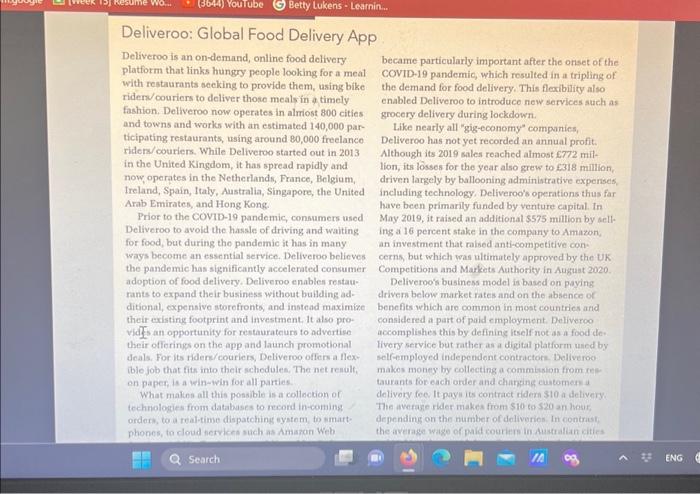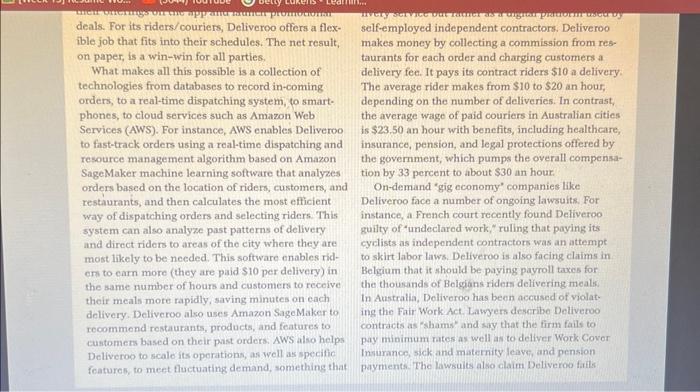(3644) YouTube Betty Lukens - Learnin... Deliveroo: Global Food Delivery App Deliveroo is an on-demand, online food delivery platform that links hungry people looking for a meal with restaurants seeking to provide them, using bike riders/couriers to deliver those meals in a timely fashion. Deliveroo now operates in almost 800 cities and towns and works with an estimated 140,000 par- ticipating restaurants, using around 80,000 freelance riders/couriers. While Deliveroo started out in 2013 in the United Kingdom, it has spread rapidly and now operates in the Netherlands, France, Belgium, Ireland, Spain, Italy, Australia, Singapore, the United Arab Emirates, and Hong Kong. WO... Prior to the COVID-19 pandemic, consumers used Deliveroo to avoid the hassle of driving and waiting for food, but during the pandemic it has in many ways become an essential service. Deliveroo believes the pandemic has significantly accelerated consumer adoption of food delivery. Deliveroo enables restau- rants to expand their business without building ad- ditional, expensive storefronts, and instead maximize their existing footprint and investment. It also pro- vides an opportunity for restaurateurs to advertise their offerings on the app and launch promotional deals. For its riders/couriers, Deliveroo offers a flex- ible job that fits into their schedules. The net result, on paper, is a win-win for all parties. What makes all this possible is a collection of technologies from databases to record in-coming orders, to a real-time dispatching system, to smart- phones, to cloud services such as Amazon Web Search became particularly important after the onset of the COVID-19 pandemic, which resulted in a tripling of the demand for food delivery. This flexibility also enabled Deliveroo to introduce new services such as grocery delivery during lockdown. Like nearly all "gig-economy" companies, Deliveroo has not yet recorded an annual profit. Although its 2019 sales reached almost 772 mil- lion, its losses for the year also grew to 318 million, driven largely by ballooning administrative expenses, including technology. Deliveroo's operations thus far have been primarily funded by venture capital. In May 2019, it raised an additional $575 million by sell- ing a 16 percent stake in the company to Amazon, an investment that raised anti-competitive con- cerns, but which was ultimately approved by the UK Competitions and Markets Authority in August 2020. Deliveroo's business model is based on paying drivers below market rates and on the absence of benefits which are common in most countries and considered a part of paid employment. Deliveroo accomplishes this by defining itself not as a food de- livery service but rather as a digital platform used by self-employed independent contractors. Deliveroo makes money by collecting a commission from res- taurants for each order and charging customers a delivery fee. It pays its contract riders $10 a delivery. The average rider makes from $10 to $20 an hour, depending on the number of deliveries. In contrast, the average wage of paid couriers in Australian cities IA ENG



Deliveroo: Global Food Delivery App Deliveroo is an on-demand, online food delivery platform that links hungry people looking for a meal with restaurants seeking to provide them, using bike riderd/couriers to deliver those meals in a timely. fashion. Delfveroo now operates in almiost 800 cities and towns and works with an estimated 140,000 participating restaurants, using around 80,000 freelance riders/couriers. While Deliveroo started out in 2013 in the United Kingdom, it has spread rapidly and now, operates in the Netherlands, France, Belgium, Ireland, Spain, Italy, Australia, Singapore, the United Arab Emirates, and Hong Kong. Prior to the COVID-19 pandemic, consumers used Deliveroo to avoid the hassie of driving and waiting for food, but during the pandemic it has in many ways become an essential service, Deliveroo believes the pandemic has significantly accelerated consumer adoption of food delivery. Deliveroo enablen restaurants to expand their business without bullding additional, expennive storefronts, and instead maximize their existing footprint and investment. It also providfs an opportunity for restaurateurs to advortise their oflerings on the app and launch promotional deals. For its riders/couriers, Deliveroo offers a llexible job that fits into their schodules, The net renult. on paper, is a win-win for all parties What maltes all this possible is a collection of tochiolories from databuses to recond in-coming orders, to a roal-time dispatching systom, to nmatt phones, to cloud tervices such as Amaron Weh became particularly important after the oriset of the COVID-19 pandemic, which rosulted in a tripling of the demand for food delivery. This flexibility also enabled Deliveroo to introduce new services such as grocery delivery during lockdown. Like nearly all "gig-economy" companies, Deliveroo has not yet recorded an annual profit. Although its 2019 sales reached aimost E72mil lion, its losses for the year also grew to 2318 million, driven largely by ballooning administrative expenses, including technology. Deliveroo's operations thus far have been primarily funded by venture capital. In May 2019, it raised an additional $575 million by selling a 16 percent stake in the company to Amazon, an investment that raised anti-competitive concerns, but which was ultimately approved by the UK Competitions and Markets Authority in Ausust 2020. Deliveroos business model is based on paying drivers below market rates and on the absence of benefits which aro common in most countries and considered a part of paid employment. Deliveroo accomplishes this by defining itself not asa food de. livery service but rather as a digital platform used by selfemployed independent contractork. Doliveroo makos money by collecting a commission from res: taurants for each order and chatying customen is delivery fee. It paym its contract ridern $10 a detivery. The average rher makea from 510 to $20 an hour, depending on the number of deliverien In contrist the average wige of paid couriein in dustratian cities deals. For its riders/couriers, Deliveroo offers a flexible job that fits into their schedules. The net result, on paper, is a win-win for all parties. What makes all this possible is a collection of technologies from databases to record in-coming orders, to a realtime dispatehing system, to smart. phones, to cloud services such as Amazon Web Services (AWS). For instance, AWS enables Deliveroo to fast-track orders using a real-time dispatching and resource management algorithm based on Amazon SageMaker machine learning software that analyzes orders based on the location of riders, customers, and restaurants, and then calculates the most efficient way of dispatching orders and selecting riders. This system can also analyze past patterns of delivery and direct riders to areas of the city where they are most likely to be needed. This software enables riders to earn more (they are paid $10 per delivery) in the same number of hours and customers to receive their meals more rapidly, saving minutes on each delivery. Deliveroo also uses Amazon Sage Maker to recommend restaurants, products, and features to customers based on their past orders. AWS also helps Deliveroo to scale its operations, as well as specific features, to meet fluctuating demand, something that self-employed independent contractors. Deliveroo makes money by collecting a commission from restaurants for each order and charging customers a delivery fee. It pays its contract riders $10 a delivery. The average rider makes from $10 to $20 an hour, depending on the number of deliveries. In contrast, the average wage of paid couriers in Australian cities is $23.50 an hour with benefits, including healthcare, insurance, pension, and legal protections offered by the government, which pumps the overall compensation by 33 percent to about $30 an hour. On-demand 'gig economy' companies like Deliveroo face a number of ongoing lawsuits. For instance, a French court recently found Deliveroo guilty of "undeclared work," ruling that paying its cyclists as independent contractors was an attempt to skirt labor liws. Deliveroo is also facing claims in Belgium that it should be paying payroll taxes for the thousands of Belgions riders delivering meals. In Australia, Doliveroo has been accused of violating the Fair Work Act. Lawyers deseribe Deliveroo contracts as "shams" and siny that the firm fails to pay minimum rates as well as to deliver Work Cover Invurance, sick and maternity leave, and pension payments. The lawsuits also claim Deliveroo firis to provide for safety training for riders and safety checks of bikes, resulting in numerous injuries to riders and pedestrians. The company claims it does not control workern, while the lawsuits and riders themselves claim Deliveroo exercises near complete control over riders by requiring uniforms, dispotching riders to restaurants and customers, tracking their performance, and disciplining those who do not meet its productivity requirements. Does Deliveroo have a viable business model? In the past, it has had no trouble attracting riders to work for below minimum wages. But it is finding it increasingly difficult to defend the legal status of rid. ers as contractors. As the global economy expands again and wages increase, Deliveroo may find its CASE STUDY QUESTIONS 1. Based on your reading of the chaptior what kind of business model is Deliveroe usins? Is it different from or the sime as Uber? 2. What tochnologies are used by Deliveroo to supe future growth impaired by labor shortages and rising wages rogardless of the resuit of the many lawsuits and court decisions. Sounces, AWS, Delivet0o Finds Injmedients for secers with AW8 + ansamasoncotn, accessed December 29, 20e0; Tim Dradshaw, "Delivethos Lasses Seared thebore Jes Pandemie Hecovery. JTcum. teceember 21, 2020, Stm shend, hevild Has Aoceleraied the Nopdon of Online Food Delivery by 2 bo 3 vedin Deliverod CEC Stym, CEFC Deciember 3, 2020, Arthio Michell stmaton Jinally Wins hpevval trom Regulaters fo Gobble Up. Mtinatiey seate in Delsveroo," Mtarkermaschicorm, August d, 2020, Francel4, France Taults Dettrearoo in Undeclared Work lavilait," Franced com. rebruary 7, zopo, Campioell Wwan, "Deliveroe Lacei tawaul for Allegrdly Underpuying Food Dellucry Ridern," znet com, Augut. 38. 2010, Fllie Donnelly; Beliveroo Fustracks Grdern Tharles mo 3. What's the differcnce betwoen an employee and a contractor? 1. What risk factors might limit Deliveroos growth in the future









